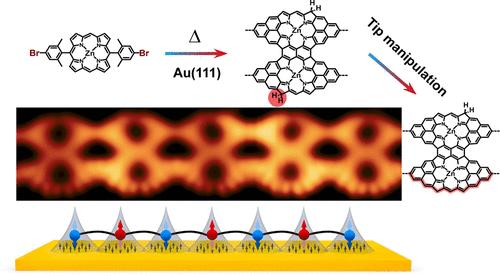Construction of Kondo Chains by Engineering Porphyrin π-Radicals on Au(111)
IF 15.6
1区 化学
Q1 CHEMISTRY, MULTIDISCIPLINARY
引用次数: 0
Abstract
Quantum manipulation of molecular radical spins provides a crucial platform for exploring emergent phenomena in many-body systems. Here, we combine surface-confined synthesis with scanning tunneling microscopy (STM) tip-induced dehydrogenation to achieve atom-precise engineering of quasi-one-dimensional porphyrin-based Kondo chains (1–7 units) on Au(111). High-resolution STS measurements and low-energy effective modeling collectively demonstrate that π-radicals at each fused-porphyrin unit form Kondo singlets screened by conduction electrons. Adjacent singlets develop direct coherent coupling via quantum-state-overlap-enabled electron tunneling. Crucially, chiral symmetry in the effective model governs zero-mode distribution─present in odd-length chains yet absent in even-length chains─which dictates pronounced odd–even quantum effects in STS spectra of finite chains. Furthermore, the number of parallel porphyrin chains nonmonotonically tunes the competition between the Kondo effect and spin exchange, showing opposing trends in strength and demonstrating that both wave function overlap and the SOMO–LUMO gap collectively govern these interactions. This work simultaneously resolves the dimensional dependence of many-body correlations in confined quantum systems and pioneers approaches for quantum-critical manipulation in molecular spin architectures.

工程卟啉π自由基在Au(111)上构建近藤链
分子自由基自旋的量子操纵为探索多体系统中的突现现象提供了一个重要的平台。在这里,我们将表面约束合成与扫描隧道显微镜(STM)尖端诱导脱氢相结合,在Au(111)上实现了准一维卟啉基Kondo链(1-7单元)的原子精确工程。高分辨率STS测量和低能有效建模共同表明,在每个熔融卟啉单元π自由基形成由传导电子屏蔽的近藤单线态。相邻单线态发展直接相干耦合通过量子态重叠使电子隧穿。至关重要的是,有效模型中的手性对称性控制着零模分布──在奇长链中存在,而在偶长链中不存在──这决定了有限链的STS谱中明显的奇偶量子效应。此外,平行卟啉链的数量非单调地调节了近藤效应和自旋交换之间的竞争,显示出相反的强度趋势,并表明波函数重叠和SOMO-LUMO间隙共同控制着这些相互作用。这项工作同时解决了受限量子系统中多体相关的维度依赖性,并开创了分子自旋结构中量子临界操作的方法。
本文章由计算机程序翻译,如有差异,请以英文原文为准。
求助全文
约1分钟内获得全文
求助全文
来源期刊
CiteScore
24.40
自引率
6.00%
发文量
2398
审稿时长
1.6 months
期刊介绍:
The flagship journal of the American Chemical Society, known as the Journal of the American Chemical Society (JACS), has been a prestigious publication since its establishment in 1879. It holds a preeminent position in the field of chemistry and related interdisciplinary sciences. JACS is committed to disseminating cutting-edge research papers, covering a wide range of topics, and encompasses approximately 19,000 pages of Articles, Communications, and Perspectives annually. With a weekly publication frequency, JACS plays a vital role in advancing the field of chemistry by providing essential research.

 求助内容:
求助内容: 应助结果提醒方式:
应助结果提醒方式:


